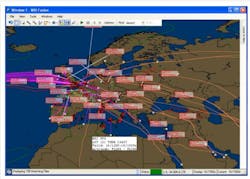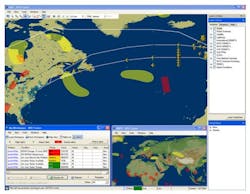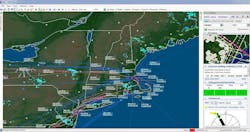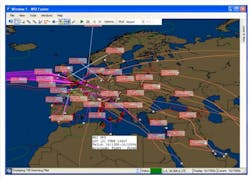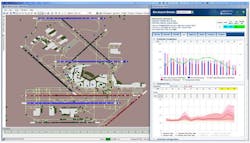Bringing the advantages of Big Data to the airport tarmac, airline operations, pilots, and ground personnel
Airports and airlines use data analytics to increase situational awareness, streamline workflow, and speed decision making, while also saving money and better serving travelers.
An interview with Mark D. Miller, senior vice president and general manager, The Weather Company, an IBM Business
Airlines lose millions of dollars each year due to excess fuel contingencies and delays at airports resulting from capacity reduction, runway configuration, and taxi time uncertainty. To provide more confident and decisive insight into these problems, Weather Services International (WSI) Aviation – part of The Weather Company, an IBM Business – in Andover, Massachusetts, integrated Predictive Airport Analytics into its WSI Fusion platform.
Fusion is the cornerstone platform of the WSI Aviation solution at more than 100 commercial airline operations centers worldwide. WSI’s real-time airline decision support system provides early insights into changing flight, airport, weather, and airspace conditions that may adversely impact operations.
Miller explains:
“Fusion is borne out of weather impacts on airport operations. We’ve been serving airlines, providing critical weather information to airline operations personnel. Fusion helps to reduce the impact of weather on operations. Specifically, Fusion monitors for weather disruptions or changes in airport operation, detects an impact or change, and alerts the operator to reduce the impact.
“The real-time platform merges data from various sources to track aircraft globally. It alerts dispatchers at the airline, and then they alert the cabin crew of turbulence or other conditions. We track all flights in the system; we can tell which flights will be impacted, and alert dispatcher and crew. It improves safety.
“It also integrates with other flight operations systems, provides information to manage all the flights in real time, and integrates a variety of data sources into a single platform.
“We recently released airport analytics services. We merged big data and data science, and applied it to airport operations. The first service is around airport impact. For example, for the next 12 hours, we can provide a forecast for weather at that airport and how weather will impact taxi times, congestion (demand/supply imbalance), the runway configuration for fuel planning (optimal fuel plan).
“It’s not just a weather forecast (wind speed, visibility, etc.); we transform weather data into the operational impact. That’s what the operator wants: to know ‘what should I do differently?’
“Fusion is used by more than 100 airlines around the world. The airport service is a new innovation to provide additional insight.
“Weather is important; knowing the forecast is key to airline and airport operations. Minutes matter in these operations. Just providing a forecast to the decision maker isn’t enough. We saw an opportunity to take all the The Weather Channel data and give airlines and airport decision makers the exact information they need to make important decisions – to transform it into what they really want to know: how the airport operation will change. Actionable information and impact for operations optimization and safety – it’s the genesis of analytics.
“Fusion is particularly useful during peak travel seasons, including winter holidays. There is more demand for both arrivals and departures, and more disruptive weather during that time of year. Very changeable weather, which can translate into longer taxi times. Fusion gives airlines these insights to reduce impact on traveling public.
“Between peak travel, demand for airspace, and disruptive weather, there’s far less margin for operational error. In an uncertain world, it means putting extra fuel on aircraft, which is more weight and higher cost.
“The Weather Company is investing significant research and development to produce the best weather forecast possible and put more confidence in decision making. Positively impact outcomes by translating data into actionable information in a transaction where minutes matter. We will continue to provide superior weather information and actionable information. Over time, the use of predictive analytics will result in better use of airspace and airports. Many constraints today are partly due to uncertainty; the skillful use of actionable information reduces uncertainty.
“All aircraft are being connected, and becoming part of the Internet of Things (IoT). They’re all connected in some way back to their operation and because of that, there are a lot of opportunities to get valuable information off aircraft and dynamically plan the operation so that you can always have the best and latest info available to pilots. That’s transformation in terms of putting ground personnel and pilots on same playbook, making informative decisions and taking positive actions. It’s about data science, connecting aircraft, and empowering pilots to safety and efficiently power aircraft.”
Along with other mission-critical systems which drive airline operations control centers, Fusion integrates with flight planning, messaging, and other proprietary data sources, further streamlining workflow and improving decision-making.
Airline decision makers use Fusion for situational awareness and assessment of weather and operational conditions to ensure passengers arrive at their destination both safely and promptly. As part of the most recent Fusion update, the predictive airport analytics service will allow the airline’s dispatchers and air traffic managers to see forecasted impacts of weather and traffic flow on airport taxi times, runway configuration, and airport congestion. Using airport predictive analytics, airlines will gain early insight into changing airport operations and be able to proactively sharpen fuel contingency, flight, and crew plans to reduce costly network and customer impacts, especially during disruptive weather.
The predictive airport analytics package contains three analytics:
Forecast airport departure arrival imbalance. Airlines can foresee potential congestion at airports and take proper actions to 1) prepare for prolong taxi time and airborne holding time by adding more fuel to prevent unnecessary diversion, and 2) protect downstream flights by ferrying additional aircraft to protect passengers downstream from delays.
Available at 77 domestic U.S. airports, including three airports in New England region: Boston Logan International Airport (BOS), Manchester-Boston International Airport (MHT), and Bradley International Airport (BDL).
Forecast airport runway configurations (both runways and directions to be used for departures and arrival) and potential timing for the change of runway configuration. Airlines can anticipate such changes and plan flight routes for the correct configuration to avoid unnecessary delay en route.
Available at 29 domestic airports, including Boston Logan International Airport (BOS) in New England.
Forecast airport taxi out and taxi in time by airlines. Airlines can use such information to appropriate fuel the aircraft. As a result, this can avoid flights from returning to gate for refueling due to long taxi out time.
Available at 29 domestic airports, including Boston Logan International Airport (BOS) in New England.
WSI Aviation, a trusted weather decision support provider serving the aviation industry, provides a proactive, aviation operation management suite ensuring common situational awareness and continuity in decisions through every phase of flight. WSI Fusion is an integral component of this flight support solution, along with Total Turbulence, which delivers precise and actionable turbulence alerts and guidance through all phases of operations, and WSI Pilotbrief, a preflight planning tool. WSI also operates a Global Forecast Center staffed by experienced aviation meteorologists who produce operational terminal and en route forecasts globally.
Weather Means Business. WSI is a provider of weather-driven business solutions that enable enterprises to make better decisions using the most accurate and precise weather data available. WSI serves some of the world's biggest brands in the aviation, energy, insurance, and media markets, as well as federal and state government agencies. WSI is part of The Weather Company, which focuses entirely on the weather, delivering billions of discrete forecasts per day around the world, through a media portfolio that includes The Weather Channel, weather.com, WSI, and Weather Underground.
WSI offers predictive airport analytics, ATM, and convective weather enhancements for improved safety and performance
Passenger air travel is growing globally at a rate of roughly five percent each year – a trend that is expected to continue through the next two decades. Airline officials and airport authorities are investigating and investing in electronics hardware and software tools to optimize the end-to-end workflow, maximize passenger and flight throughput, and reduce flight delays, cancellations, and other challenges.
A growing number of airports are implementing predictive analytics to better manage traffic, keep flights on time, and deal with fast-changing weather – helping ensure travelers’ flights are on-time and travel experiences are positive, especially during the heavy holiday travel season.
Weather Services International (WSI), the professional division of The Weather Company in Andover, Mass., has added a Predictive Airport Analytics element to its Fusion software used by airports around the world. The analytics tool enables dispatchers and air traffic coordinators to more clearly see and understand forecast impacts of weather and traffic flow on airport taxi times, runway configurations, and airport congestion, WSI officials explain.
Using WSI Fusion with Predictive Airport Analytics, airlines gain early insight into changing airport operations and can proactively sharpen fuel contingency, flight, and crew plans to reduce costly network and customer impacts, especially during disruptive weather.
“Airlines lose millions of dollars each year due to excess fuel contingencies and delays at airports resulting from capacity reduction, runway configuration, and taxi time uncertainty,” WSI officials affirm. To help reduce operating costs, WSI has integrated Predictive Airport Analytics into its WSI Fusion platform version 2015.2, and also introduced several key additions in air traffic management and convective weather to help flight dispatchers, operations personnel, and managers stay aware and ahead of changing conditions from planning to touch down.
Additional enhancements in the latest Fusion update include:
Enhanced Convective Package
Convection is a significant cause of both en route and terminal disruption, flight delays as well as safety risk. This new package features high-definition, real-time and forecast convective information, which will enable airlines to pinpoint severe weather and clarify route and terminal decisions. This update also extends coverage for many of the products globally to take the guesswork out of international operations - particularly routing near more vigorous convective activity where there has been limited information until now.
FAA Route Compliance and Significant Change Alerts
The compliance and significant change alerts will help airlines streamline operations by notifying dispatchers when their flights have a route restriction as well as when their flights are in compliance with FAA routes. This will allow the dispatcher and flight crew to ensure that a proper fuel load and routing are loaded for a timely departure.
System Wide Information Management (SWIM) Support
WSI has updated core FAA air traffic management data services to the latest available via System Wide Information Management (SWIM). The latest Fusion update meets FAA compatibility requirements with new FAA data standards for critical ground stop and route constraint information.
WSI Fusion is a flight operation platform that fuses vital weather, airport, airspace, and flight information into actionable insights and alerts, empowering operators to proactively manage and improve safety, efficiency, and performance, officials say.
Weather Services International (WSI) Fusion
WSI Fusion from Weather Services International (WSI), the professional division of The Weather Company in Andover, Mass., is a proactive operations management solution that fuses public and proprietary weather information, airspace constraints, flight information, and operational data into one clear, unified, streamlined picture to enhance operational decision-making.
WSI Fusion is designed to help dispatchers, operations personnel, and managers stay aware and ahead of changing conditions, mitigate the impact of disruptive events, and ultimately stay on plan, on time, and on budget.
WSI has integrated Predictive Airport Analytics into its WSI Fusion platform version 2015.2, and introduced several key additions in air traffic management and convective weather to help flight dispatchers, operations personnel, and managers stay aware and ahead of changing conditions from planning to touch down.
You might also like:
Subscribe today to receive all the latest aerospace technology and engineering news, delivered directly to your e-mail inbox twice a week (Tuesdays and Thursdays). Sign upfor your free subscription to the Intelligent Inbox e-newsletter at http://www.intelligent-aerospace.com/subscribe.html.
Connect with Intelligent Aerospace on social media: Twitter (@IntelligentAero), LinkedIn,Google+, and Instagram.
Intelligent Aerospace
Global Aerospace Technology NetworkIntelligent Aerospace, the global aerospace technology network, reports on the latest tools, technologies, and trends of vital importance to aerospace professionals involved in air traffic control, airport operations, satellites and space, and commercial and military avionics on fixed-wing, rotor-wing, and unmanned aircraft throughout the world.
